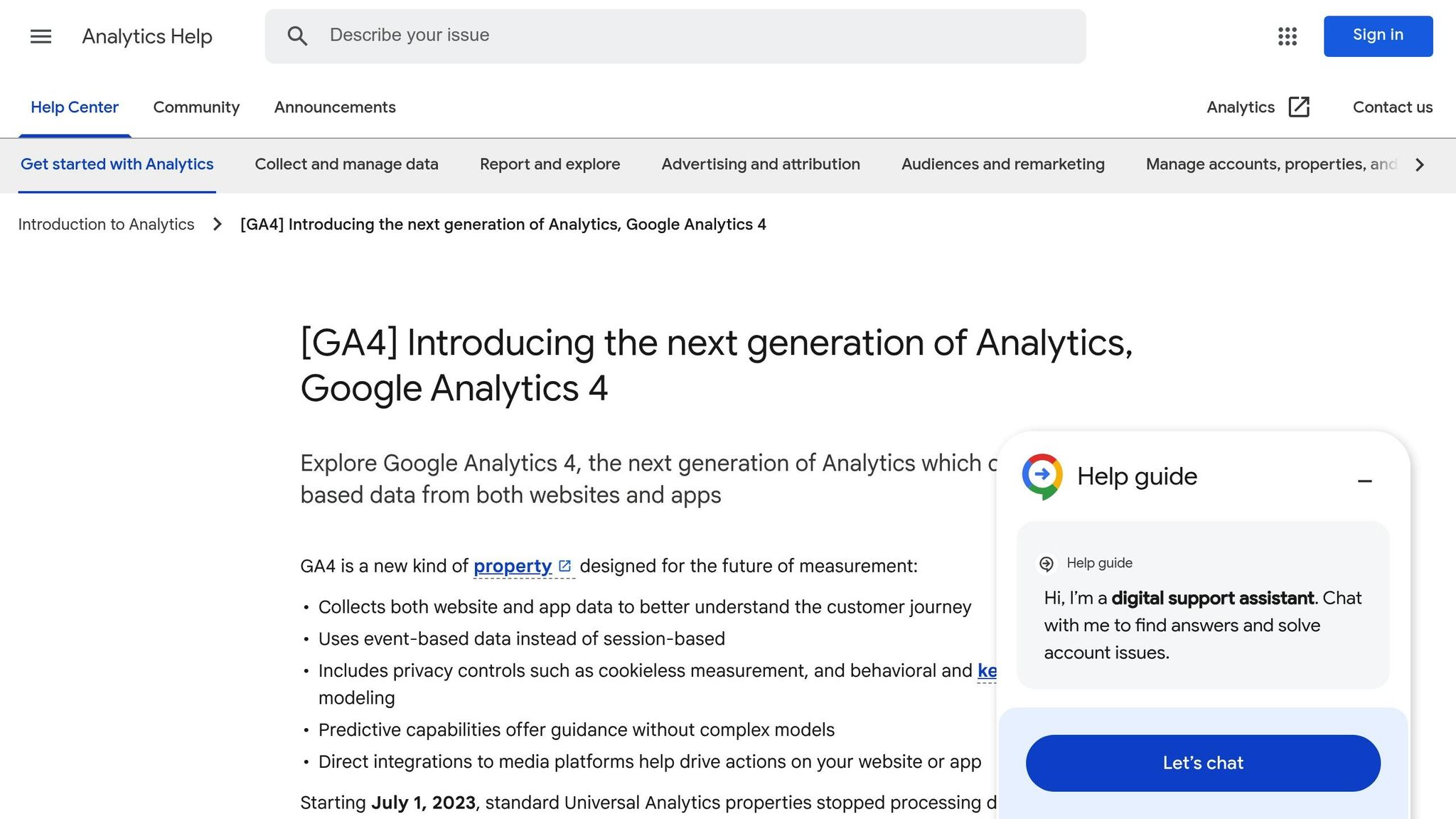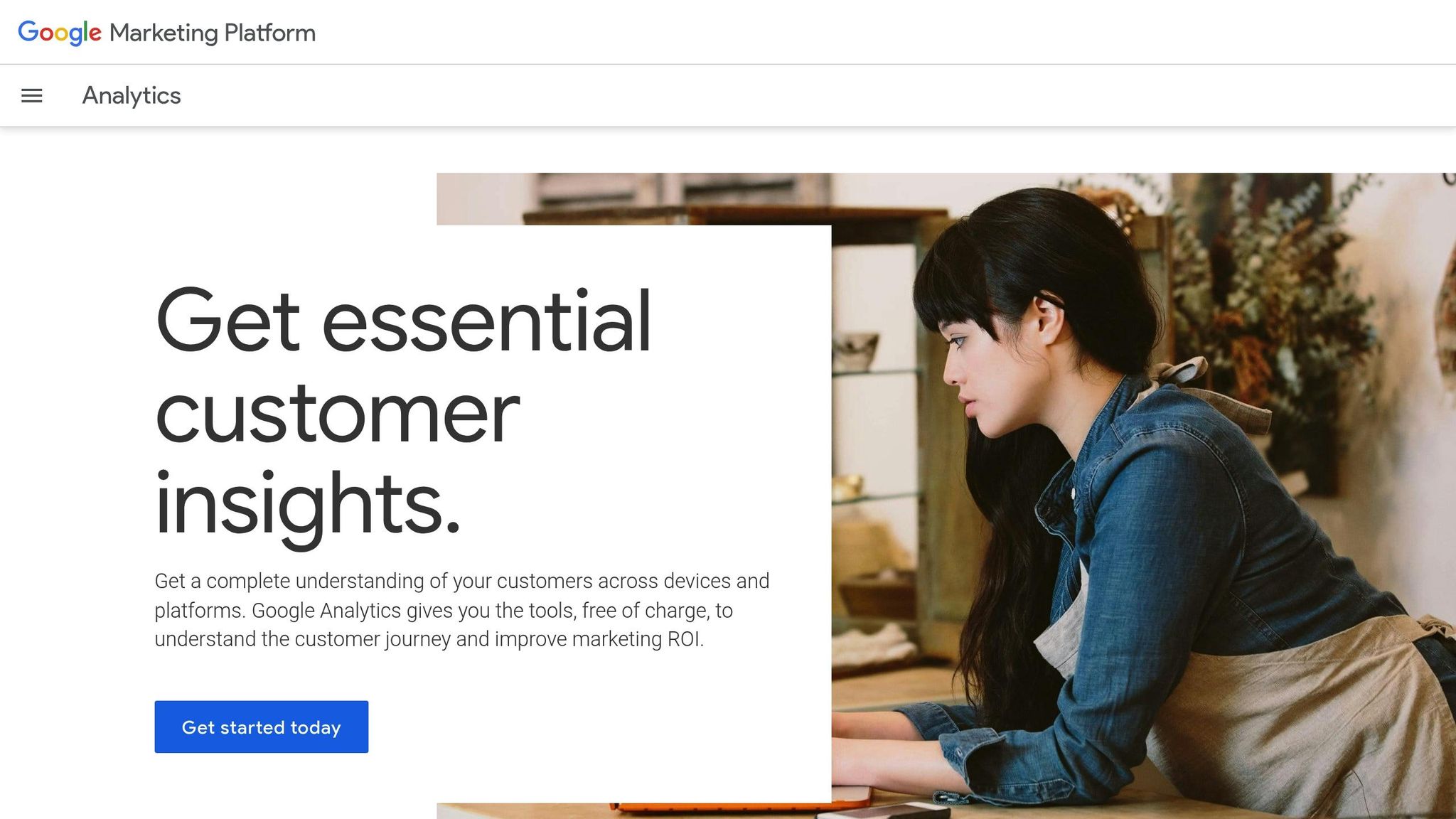Tracking organic traffic in GA4 is essential for understanding how users find your site through unpaid search results. Here’s a quick guide to help you get started:
- What is Organic Traffic? Visits from unpaid search results, unlike paid ads or direct traffic.
- Why It Matters: Organic search makes up about 33% of website traffic. It shows how well your SEO efforts perform and reveals user behavior.
- How GA4 Tracks It: GA4 uses an event-based model to track user interactions, offering detailed insights like engagement rates, conversion paths, and landing page performance.
Key Steps to Track Organic Traffic in GA4:

- Set Up Your Data Stream: Connect your website to GA4 using a Measurement ID.
- Enable Enhanced Measurement: Automatically track events like page views, scrolls, and clicks.
- Filter Bot Traffic: Exclude bots and internal traffic for cleaner data.
- Use Standard Reports: Check the Traffic Acquisition and Landing Page reports for organic traffic insights.
- Link GA4 to Google Search Console: Get keyword data, search impressions, and click-through rates.
Quick Comparison: Organic vs. Other Traffic Types
| Traffic Type | Description | How It’s Identified |
|---|---|---|
| Organic Search | Unpaid search visits | No paid parameters in the URL |
| Paid Search | Visits from ads | UTM or gclid parameters |
| Referral | Visits from other websites | Referring domain data |
| Direct | Direct URL entry/bookmarks | No referral information |
How to see Organic Traffic in Google Analytics 4

GA4 Setup for Organic Traffic
Getting your GA4 configuration right is essential for tracking organic traffic accurately. Here’s a breakdown of the key steps to ensure your data collection runs smoothly.
Data Stream Setup
A data stream connects your website to GA4, ensuring consistent data flow. Here’s how to set it up:
- Log into GA4 and navigate to Admin > Data Streams.
- Click "Add Stream" and select "Web".
- Enter your website URL and create a clear, descriptive stream name (e.g., "Main Website – Desktop").
- Copy the Measurement ID (it starts with "G-").
- Install the tracking code either through Google Tag Manager or by adding it directly to your site’s
<head>section.
Once your data stream is active, enable automatic event tracking using Enhanced Measurement.
"GA4 Data Streams simplify tracking by collecting user interactions from websites and mobile apps in one place".
Enhanced Measurement Settings
Enhanced Measurement makes event tracking easier by automatically logging key user interactions. Here’s what you can configure:
| Event Type | Purpose | Status |
|---|---|---|
| Page Views | Track page loads | Enabled |
| Scrolls | Monitor 90% scroll depth | Enabled |
| Outbound Clicks | Track external links | Enabled |
| Site Search | Track internal searches | Enabled |
| File Downloads | Track resource downloads | Enabled |
Be sure to enable these features for comprehensive tracking. Additionally, set up bot filters to keep your data clean.
Bot Traffic Removal
To maintain accurate reporting, exclude bot traffic from your GA4 data:
- Filter Internal Traffic: Use IP filters to exclude traffic from your own team by specifying IP ranges.
- Custom Bot Filters: Identify patterns (e.g., Country = (not set), Browser = Chrome, OS = Windows 10) and create filters accordingly.
- Referral Exclusions: Add spammy domains to your referral exclusion list.
GA4 also automatically filters out known bots and spiders. To confirm your setup, check the Realtime reports while interacting with your site in another browser tab.
Standard GA4 Traffic Reports
GA4’s default reports provide a detailed look at how organic traffic is performing. These built-in tools help you understand visitor behavior and uncover trends in your traffic.
Using the Acquisition Report
The Traffic Acquisition report is your go-to for analyzing where your organic traffic comes from. To find it:
- Navigate to Reports > Life cycle > Acquisition > Traffic acquisition.
- Apply a filter for "Session default channel group" that matches "Organic Search".
This report highlights key metrics to evaluate your traffic sources:
| Metric | Description |
|---|---|
| Active Users | Number of unique visitors to your site |
| Engaged Sessions | Sessions lasting more than 10 seconds |
| Engagement Rate | Percentage of sessions considered "engaged" |
| Average Engagement Time | Average time visitors actively interacted with your site |
Landing Page Analysis
The Landing Page report helps you identify which pages attract and retain the most organic traffic. GA4 automatically tracks critical metrics for each landing page, such as:
- First-time visitor numbers
- Engagement duration
- Conversion rates
- Exit rates
For more granular insights, add "Session source/medium" as a secondary dimension. This allows you to see how visitors from organic search interact with specific landing pages and provides a clearer picture of their initial behavior.
New User Traffic Sources
Understanding how new users interact with your site is key to improving their first impressions. GA4 stores this data for up to 16 months, making it easier to spot long-term trends.
Some important metrics to focus on include:
| Metric | Purpose | Requirements |
|---|---|---|
| Organic Search Clicks | Tracks the number of clicks from Google Search | Requires Search Console Link |
| Search Impressions | Counts how often your site appears in search results | Requires Search Console Link |
| Click-through Rate | Measures clicks relative to impressions | Requires Search Console Link |
| Average Position | Shows your average ranking for tracked keywords | Requires Search Console Link |
For deeper keyword insights, link your GA4 account to Google Search Console. Once connected, you’ll gain access to search query data after a 48-hour processing period. This integration is essential for tracking how your site performs in organic search results.
sbb-itb-880d5b6
Custom GA4 Traffic Reports
Custom reports in GA4 take you beyond the standard metrics, letting you zero in on organic traffic with greater precision. These reports provide a clearer picture of user behavior and the effectiveness of your campaigns.
Organic Traffic Segment Creation
To create a custom organic traffic report:
- Go to Explore > Create New Exploration > Blank and name your report "Organic Search Traffic Analysis."
- Set up a user segment by filtering for "First user medium" equals "organic." Then, import the following dimensions:
| Dimension Category | Key Dimensions to Include |
|---|---|
| Traffic Sources | First user source/medium, Landing Page + query string |
| User Info | Device Category, Browser, Country |
| Behavior | Event Name, Item Name |
| Custom | Campaign parameters (if applicable) |
Advanced Traffic Analysis Tools
After defining your organic segment, you can dig deeper using advanced tools in GA4. For example:
- Path Exploration: Map out visitor journeys to see how users navigate your site.
- Attribution Reports: Measure the impact of organic search on conversions.
You can also leverage specialized report types for specific insights:
| Report Type | Purpose | Key Metrics |
|---|---|---|
| User Flow | Track visitor navigation patterns | Page sequence, drop-off points |
| Funnel Analysis | Monitor conversion paths | Conversion steps |
| Path Exploration | Analyze user journeys | Event sequences |
These tools give you a more detailed view of how users interact with your site, helping you identify opportunities for SEO improvements.
Custom Metric Dashboards
To keep an eye on organic traffic performance, build a dashboard with key performance indicators (KPIs). Include metrics like:
- Views and total users
- Sessions and engaged sessions
- Engagement rate
- Event count
- Conversions
- Total revenue
"Actually, you can ignore any data from external SEO tools since SEO success shouldn’t be measured by where you appear on a search results page that a hypothetical user might see if they searched a hoped-for keyword. Keyword visibility only matters if your ideal customer profile clicks those results and lands on your website."
– Eli Schwartz, Author of Product-Led SEO
Reading Organic Traffic Data
Once you’ve set up and reviewed the standard GA4 reports, you can dive deeper into understanding organic visitor behavior by analyzing key engagement metrics. These metrics can help you uncover patterns and trends in how users interact with your site.
User Engagement Metrics
In GA4, engagement metrics provide a window into user behavior. A session is considered "engaged" if it meets at least one of these criteria:
- Lasts longer than 10 seconds
- Includes a conversion event
- Has two or more page views
Here are some important metrics to keep an eye on:
| Metric | Benchmark | What It Tells You |
|---|---|---|
| Engagement Rate | 54.88% average | Percentage of sessions that are engaged |
| Average Engagement Time | 52 seconds | Time the page was actively in focus |
| Bounce Rate | 45% average | Percentage of sessions that were not engaged |
For B2B websites, aim for engagement rates above 63%. For B2C websites, the target is higher – over 71%. If your metrics fall below these benchmarks, use GA4’s exploration reports to dig deeper into the data.
Conversion Tracking
Once you’ve analyzed engagement, the next step is to track how organic traffic contributes to your business goals. Conversion tracking in GA4 helps you identify which traffic sources are driving results.
"Conversion tracking reveals which traffic sources are best helping you reach your goals. So you can focus your marketing efforts and budget accordingly." – Zack Duncan
Here are the key metrics to monitor for conversion tracking:
| Conversion Metric | What It Measures | What to Do |
|---|---|---|
| User Conversion Rate | Percentage of users who convert | Compare this against total traffic |
| Session Conversion Rate | Conversions per session | Track the multi-session journey |
| Total Conversions | Total number of conversion events | Look for trends and changes over time |
By tracking these metrics, you can better understand how organic traffic aligns with your business objectives.
Landing Page Success Metrics
Landing page performance is another critical area to analyze. These metrics give you insights into how visitors interact with your site right from the start. To avoid known issues, use the ‘Landing page + query string’ dimension instead of just ‘Landing Page’.
Focus on these indicators:
- Average Engagement Time: Compare this to the 52-second benchmark.
- Conversion Performance: Identify trends in how landing pages contribute to conversions over time.
- User Flow: See how visitors navigate after arriving on a landing page.
Integrating GA4 with Google Search Console can also help you understand which keywords are driving traffic. Use this data to evaluate content relevance, refine your technical SEO, and adjust your strategy based on user behavior and performance metrics.
Conclusion: GA4 Organic Traffic Tips
Main Points Review
GA4’s event-based tracking model changes the game for monitoring organic traffic, offering a detailed view across devices and platforms. With benchmarks like an average session duration of 2 minutes and 19 seconds and a bounce rate of 45.9%, you can measure your site’s performance against industry norms.
"GA4, while more powerful in many ways than the legacy Universal Analytics platform, requires re-learning how to set up and navigate the GA interface".
These tools and insights provide a solid foundation for refining your tracking methods.
Improving Your Traffic Tracking
To make the most of GA4’s capabilities, try these strategies to sharpen your tracking accuracy:
| Action Item | How to Implement | What to Expect |
|---|---|---|
| Filter Setup | Exclude traffic from your team and partners | Cleaner, more reliable data |
| GSC Integration | Link GA4 with Google Search Console | Access to organic keyword insights |
| Conversion Tracking | Define and track key conversion events | Align SEO efforts with business goals |
FAQs
How can I make sure GA4 tracks organic traffic accurately without including bots or internal users?
To make sure your Google Analytics 4 (GA4) provides accurate organic traffic data, it’s important to filter out both internal and bot traffic from your reports.
Start with excluding internal traffic. Head to your GA4 property, navigate to the Admin section, and locate your web data stream under Data Streams. Within the settings, you can define internal traffic by specifying the IP addresses of your team or office. Once set up, GA4 will filter out traffic from those sources.
Next, ensure bot filtering is active. GA4 automatically filters known bots and spiders, but it’s worth double-checking. You can do this by going to Admin > Data Settings > Data Filters and confirming the bot filtering option is enabled.
By following these steps, you’ll keep your organic traffic data clean and trustworthy.
What are the advantages of connecting Google Analytics 4 (GA4) with Google Search Console for tracking organic traffic?
Connecting GA4 with Google Search Console gives you a deeper understanding of your website’s organic performance. This integration allows you to examine search queries, impressions, and click-through rates while also tracking user behavior metrics. Together, these insights provide a well-rounded picture of how people discover and interact with your site.
By linking these tools, you can pinpoint which keywords bring in traffic, assess your site’s position in search results, and connect organic traffic patterns with user engagement. Plus, it streamlines reporting by letting you view Search Console data directly in GA4. This makes it easier to fine-tune your SEO strategies and improve your content to meet your audience’s needs.
How does GA4’s event-based model provide better insights into user behavior compared to Universal Analytics?
Google Analytics 4 (GA4) introduces a smarter way to track user behavior with its event-based tracking model, capturing every interaction – such as clicks, video plays, or form submissions – as a distinct event. Unlike Universal Analytics, which relied on session-based tracking, GA4 makes it easier to monitor these actions without needing complicated manual configurations.
This model not only simplifies how you track user activity but also gives you deeper insights into user journeys and engagement trends. On top of that, GA4 uses machine learning to provide predictive analytics, bridging gaps in your data and offering actionable recommendations. This means you can better understand how users navigate your site or app and make informed changes to enhance their experience.




